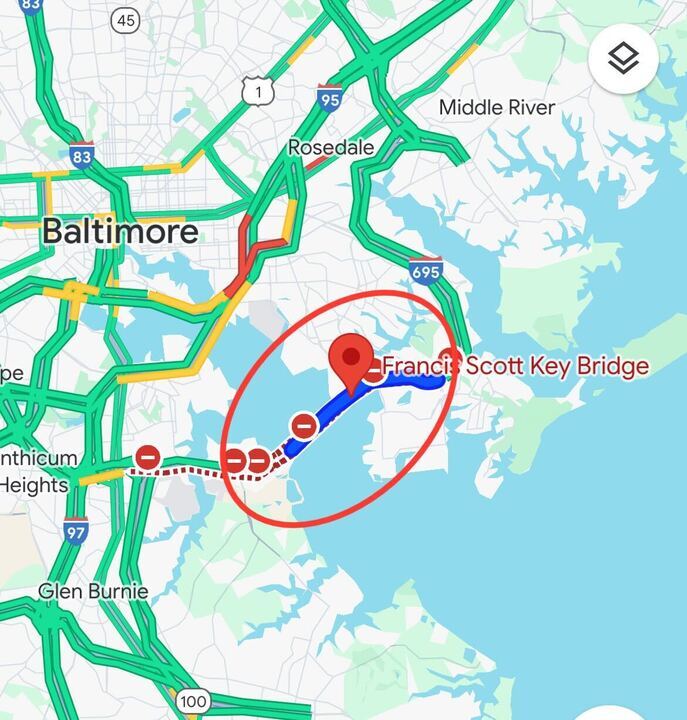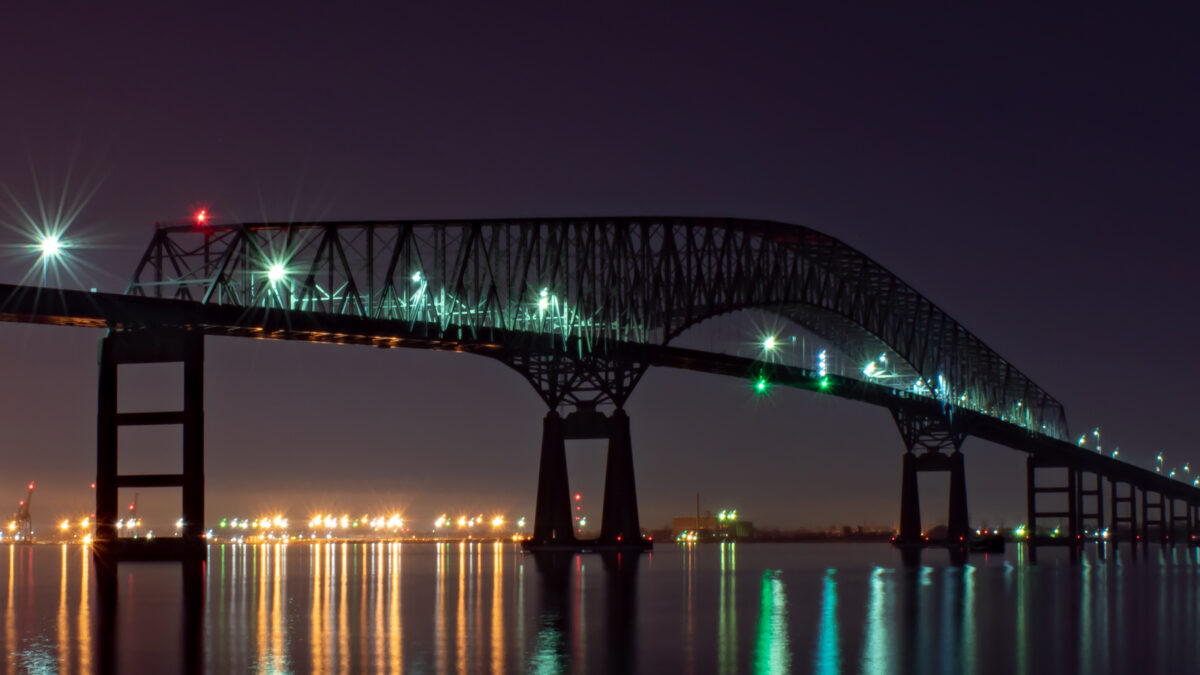A large section of the Francis Scott Key Bridge in Baltimore collapsed early Tuesday morning, after a container ship collided with it. The incident sent vehicles into the water, initiated a large-scale search-and-rescue operation, and has serious implications for one of the busiest ports on the U.S. East Coast.
The Port of Baltimore announced at approximately 8 a.m. Eastern that it was closed for inbound and outbound vessel traffic. It did say that truck operations at terminals inside the port would continue.
But the bridge collapse effectively sets up a wall between the port and Chesapeake Bay. There does not appear to be any other inbound or outbound way between the port and shipping lanes, raising the question of how long this key terminal will be closed.

The Maryland Transportation Authority is advising against the use of Interstate 695, a key route for Baltimore’s commuters and freight movement, following the collapse. The bridge plays a vital role in commercial shipping access to the Port of Baltimore, a major hub for autos, light trucks and various bulk goods. It is the easternmost way of getting across the Port of Baltimore.
The actual waterway the bridge collapsed into is the Patapsco River, which ultimately flows into Chesapeake Bay and near its end forms the boundaries of the Port of Baltimore.
Alternate routes for trucks that bypass the Key bridge are a tunnel on Interstate 895 under the Baltimore Harbor, a tunnel on Interstate 95 under the harbor, or Interstate 695 on the west side of Baltimore. The bridge is part of Interstate 695, the Baltimore Loop, on the east side of the city.
The Maryland Transportation Authority on its X feed, noted that vehicles transporting hazardous materials may not use either the I-95 (Fort McHenry) or I-895 (Baltimore Harbor) tunnels. To get around Baltimore, they will need to use I-695 on the western side of the city.
Additionally, MDTA said on X that vehicles in excess of 13 feet, 6 inches in height or 8 feet in width are prohibited from using the Baltimore Harbor Tunnel on I-895. For the Fort McHenry Tunnel, which is part of I-95 through the heart of Baltimore, the limits are 14 feet 6 inches in height and 11 feet in width.
Paul Wiedefeld, Maryland’s transportation secretary, said the water where the bridge was struck is about 50 feet deep, complicating search-and-rescue operations. The U.S. Coast Guard and dive teams are currently searching for survivors, with Baltimore’s fire chief noting the additional challenges posed by the water’s current.
Initial reports indicate possible multiple casualties. The effort to locate survivors is critical, with water temperatures around 47 degrees Fahrenheit adding to the urgency.
During a press conference, Moore said that a mayday had been sent and that vehicle traffic on the bridge was stopped right before its collapse. It’s unclear if any passenger vehicles traveling on the bridge at the time went into the water.
Officials said there is no indication of foul play.
RELATED: The deadliest bridge collapse in modern history
The Dali, the Singapore-flagged ship involved, was carrying around 4,900 containers at the time of the collision. It hit the bridge while under pilotage, disrupting not just the vessel’s journey from the U.S. to Sri Lanka but also the operations at the port and the flow of traffic on surrounding roadways.
News reports say the Dali was chartered by Maersk but managed by the Synergy Group. Reports also say the ship was owned by Singapore’s Grace Ocean Pte. The statement published by the Synergy Group about the crash said there were no casualties on the ship and no fuel was spilled.
Maryland Gov. Wes Moore has declared a state of emergency and is seeking federal assistance. The bridge’s collapse not only affects local commuters but also poses challenges to freight transportation, especially as the Easter holiday weekend approaches. The Port of Baltimore, known for handling a large volume of imports and exports, faces immediate operational hurdles.
Authorities are focused on rescue operations and determining the full extent of the disruption to commerce and traffic.

One social media observation about the crash is that in terms of its impact on logistics, the West Coast ports — battered by a pandemic-driven movement toward East Coast ports — now face the prospect of another development that suddenly makes Long Beach and Los Angeles look more attractive.
Avoiding East Coast ports to skip the limits on a drought-stricken Panama Canal already were seen as helping the West Coast ports. Add to that any avoidance of the East Coast as a knock-on effect from the threat to shipping in the Red Sea and Suez Canal, and now one of the East Coast’s biggest ports effectively has a steel blockade that is likely to take months to remove.
Judah Levine, head of research at Freightos, the international shipping transaction and payment platform, laid out the impact on shipping in an email to FreightWaves.
“With most of Baltimore’s port terminals and all of its container terminals behind the collapsed bridge, containerized exports at or planning to depart from Baltimore will either need to wait until the waterway re-opens, or be rerouted by truck or rail to alternate ports which could include Philadelphia or more likely the more major hubs like Norfolk or New York/New Jersey,” he said. “Exporters choosing these options could face increased trucking and rail rates if enough volumes are shifted to other ports.”
Levine said seven container vessels are scheduled to arrive in Baltimore between now and Saturday.
“Diversions could cause some congestion at alternative ports, meaning delays for importers,” Levine said.
But quarterly container volumes at Baltimore are only about 13% of those handled at the Port of New York/New Jersey, he added. “Baltimore imports should be able to be shifted to other ports without causing too much of a disruption.”












Eric Kulisch
Interesting point, Eltee.
Eltee
vessel
Eltee
With all of the clarity and hopefully non of the hubris of the Monday Morning Quarterback
and with the memory of the Sunshine Skyway bridge collapse after being struck by sea going vessle in Tampa still in tact,
one HAS to ask… why, when tugs are needed to move a ship from the berth to the channel and when, at that point,
both tug(s) and vessle are little more that 1 mile from the Key bridge, would a protocol not be developed to provide
that little extra bit of insurance of escorting outbound ships BEYOND the bridge before cutting them loose?